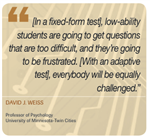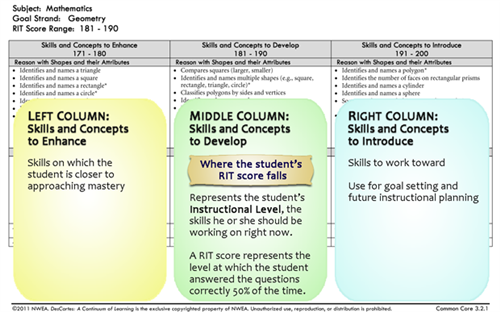- Teaching and Learning
- NWEA MAP Assessment
Mathematics
Page Navigation
-
Each type of assessment used in the School District of Clayton measures student growth and achievement in a slightly different way, supplying the District with a more complete picture of a student's learning profile than any one of them could alone.
NWEA MAP
The NWEA™ Measures of Academic Progress® (MAP®) is a computer-adaptive assessment that measures what students know regardless of grade level. Students participate in this assessment at various points of their tenure in Clayton. This assessment is one indicator that is used to measure student academic growth in mathematics. This assessment provides teachers with reliable, useful data, which can be used to identify each student’s instructional level and design optimal learning experiences.
One Data Point
Similar to other assessments your child participates in, this is one piece of data that makes up their complete data profile. It is important to understand that the NWEA MAP is one test at one point in time and does not measure intelligence or a student’s capacity for learning. When making important decisions about students, the NWEA MAP test is only one piece of data that is considered.
Computer Adaptive Unlike the Missouri MAP assessment, which is a fixed-form assessment, the NWEA MAP assessment is computer adaptive. This means that the difficulty of each question is based on the student’s answers on previous questions. A correct answer will lead to a more difficult question, and an incorrect answer will lead to an easier question but more difficult than the last correctly answered question. The assessment takes approximately 30 minutes for second-fifth-graders and 60 minutes for sixth-eighth-graders and uses approximately 50 questions to determine a student’s score called a RIT. RIT stands for Rausch Unit. The RIT scale is and equal-interval measurement scale (much like feet and inches on a yardstick) independent of a student's grade or age. Each RIT score falls in a 10-point RIT band that relates directly to learning objectives.RIT Reference Chart:
Unlike the Missouri MAP assessment, which is a fixed-form assessment, the NWEA MAP assessment is computer adaptive. This means that the difficulty of each question is based on the student’s answers on previous questions. A correct answer will lead to a more difficult question, and an incorrect answer will lead to an easier question but more difficult than the last correctly answered question. The assessment takes approximately 30 minutes for second-fifth-graders and 60 minutes for sixth-eighth-graders and uses approximately 50 questions to determine a student’s score called a RIT. RIT stands for Rausch Unit. The RIT scale is and equal-interval measurement scale (much like feet and inches on a yardstick) independent of a student's grade or age. Each RIT score falls in a 10-point RIT band that relates directly to learning objectives.RIT Reference Chart:
The RIT Reference Chart is helpful for understanding the RIT scale and how it is used to measure student growth over time in relationship to math concepts. For more specific information about the learning statements within each RIT band, you can reference the DesCartes Learning Continuum Statements below.DesCartes Learning Continuum Statements:
Using Learning Continuum statements, you can see what students performing at a given RIT level are typically ready to learn. Learning statements for a RIT band are divided into three columns. The left-hand column includes skills and concepts related to questions your child answered correctly 73 percent of the time. These are skills and concepts students may need reinforced to build consistent proficiency and confidence. The middle column includes skills and concepts related to questions your child answered correctly 50 percent of the time. These are skills and concepts your child is ready to learn. The column on the right includes skills and concepts related to questions your child answered correctly 27 percent of the time. These are skills and concepts in which your child may be ready to be introduced. To use the Learning Continuum, reference the page that shows the RIT band in which your child's score fell for each subject area. For example, if your child is in fourth grade and his/her RIT Range for the goal performance area of Geometry is 216-228, you would open the Geometry document below under Grades 2-5 and turn to the page where the RIT band 211-220 or 221-230 is in the center column.
Learning Continuum Statements Grades K-1: Goal Area DescriptionsGrades 6-12: Goal Area Descriptions Grades 2-5: Goal Area Descriptions Geometry Geometry Measurement & Data Statistics & Probability Numbers & Operations Real & Complex Number System Operations & Algebraic Thinking Operations & Algebraic Thinking Vocabulary RIT to Khan Academy ResourceIf you would like to talk further about your child's NWEA MAP results, feel free to contact your child's teacher, Math Specialist, or Subject Manager at his/her school.Captain: tylerharger@claytonschools.netGlenridge: susannahscotino@claytonschools.netMeramec: kimberlymeininger@claytonschools.netWydown: kelseykoenig@claytonschools.net

